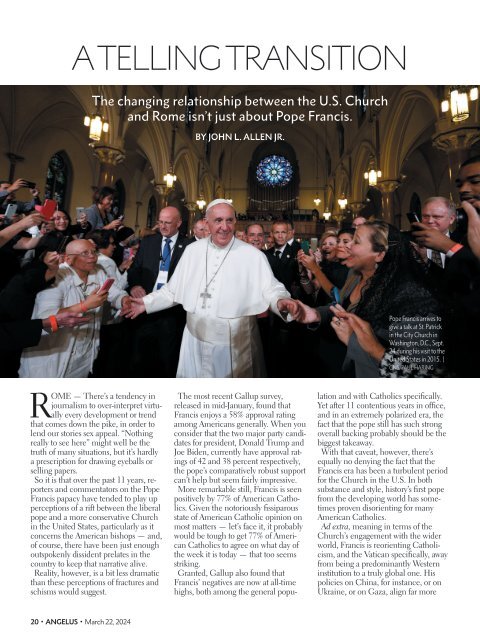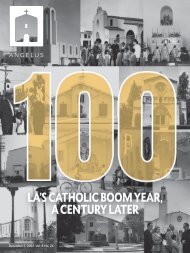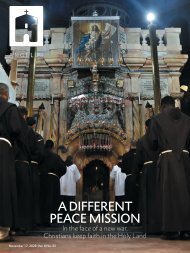Angelus News | March 22, 2024 | Vol. 9 No. 6
On the cover: To cap off a nearly five-decades-long career working in Church communications, Francis X. Maier had an ambitious book idea: a ‘snapshot’ of the Church in America at this time in history that captured both its strengths and its sicknesses. On Page 10, Maier shares what he took away from hearing more than 100 “confessions”’ with American Catholic leaders for the project. On Page 20, John L. Allen Jr. offers his own diagnosis of the uneasy relationship between U.S. Catholics and Rome during the Pope Francis pontificate.
On the cover: To cap off a nearly five-decades-long career working in Church communications, Francis X. Maier had an ambitious book idea: a ‘snapshot’ of the Church in America at this time in history that captured both its strengths and its sicknesses. On Page 10, Maier shares what he took away from hearing more than 100 “confessions”’ with American Catholic leaders for the project. On Page 20, John L. Allen Jr. offers his own diagnosis of the uneasy relationship between U.S. Catholics and Rome during the Pope Francis pontificate.
You also want an ePaper? Increase the reach of your titles
YUMPU automatically turns print PDFs into web optimized ePapers that Google loves.
A TELLING TRANSITION<br />
The changing relationship between the U.S. Church<br />
and Rome isn’t just about Pope Francis.<br />
BY JOHN L. ALLEN JR.<br />
Pope Francis arrives to<br />
give a talk at St. Patrick<br />
in the City Church in<br />
Washington, D.C., Sept.<br />
24 during his visit to the<br />
United States in 2015. |<br />
CNS/PAUL HARING<br />
ROME — There’s a tendency in<br />
journalism to over-interpret virtually<br />
every development or trend<br />
that comes down the pike, in order to<br />
lend our stories sex appeal. “<strong>No</strong>thing<br />
really to see here” might well be the<br />
truth of many situations, but it’s hardly<br />
a prescription for drawing eyeballs or<br />
selling papers.<br />
So it is that over the past 11 years, reporters<br />
and commentators on the Pope<br />
Francis papacy have tended to play up<br />
perceptions of a rift between the liberal<br />
pope and a more conservative Church<br />
in the United States, particularly as it<br />
concerns the American bishops — and,<br />
of course, there have been just enough<br />
outspokenly dissident prelates in the<br />
country to keep that narrative alive.<br />
Reality, however, is a bit less dramatic<br />
than these perceptions of fractures and<br />
schisms would suggest.<br />
The most recent Gallup survey,<br />
released in mid-January, found that<br />
Francis enjoys a 58% approval rating<br />
among Americans generally. When you<br />
consider that the two major party candidates<br />
for president, Donald Trump and<br />
Joe Biden, currently have approval ratings<br />
of 42 and 38 percent respectively,<br />
the pope’s comparatively robust support<br />
can’t help but seem fairly impressive.<br />
More remarkable still, Francis is seen<br />
positively by 77% of American Catholics.<br />
Given the notoriously fissiparous<br />
state of American Catholic opinion on<br />
most matters — let’s face it, it probably<br />
would be tough to get 77% of American<br />
Catholics to agree on what day of<br />
the week it is today — that too seems<br />
striking.<br />
Granted, Gallup also found that<br />
Francis’ negatives are now at all-time<br />
highs, both among the general population<br />
and with Catholics specifically.<br />
Yet after 11 contentious years in office,<br />
and in an extremely polarized era, the<br />
fact that the pope still has such strong<br />
overall backing probably should be the<br />
biggest takeaway.<br />
With that caveat, however, there’s<br />
equally no denying the fact that the<br />
Francis era has been a turbulent period<br />
for the Church in the U.S. In both<br />
substance and style, history’s first pope<br />
from the developing world has sometimes<br />
proven disorienting for many<br />
American Catholics.<br />
Ad extra, meaning in terms of the<br />
Church’s engagement with the wider<br />
world, Francis is reorienting Catholicism,<br />
and the Vatican specifically, away<br />
from being a predominantly Western<br />
institution to a truly global one. His<br />
policies on China, for instance, or on<br />
Ukraine, or on Gaza, align far more<br />
20 • ANGELUS • <strong>March</strong> <strong>22</strong>, <strong>2024</strong>

















